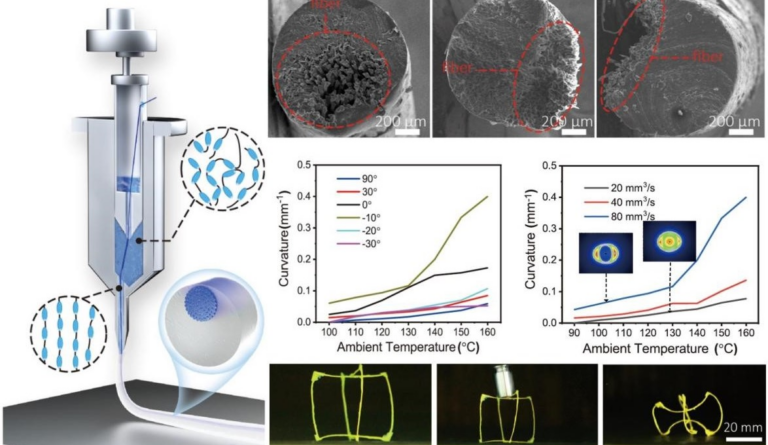Researchers develop 4D printing method for fiber reinforced liquid crystal elastomers
Xi’an, China – The research team of China’s Xi’an Jiaotong University used the reversible thermochrome deformation ability of liquid crystal elastomers, combined with the excellent mechanical properties of continuous fiber materials, to propose a direct-writing 4D printing method based on continuous fiber-reinforced liquid crystal elastomers. The continuous fibers embedded in the liquid crystal elastomer composite material played a role in significantly enhancing the mechanical properties and realizing the effect of bending deformation.
The printing method can obtain the controllable load-bearing characteristics and deformation shape of the printed structure by adjusting the offset position of the fiber inside the composite filament. The printed liquid crystal composite can withstand a load up to 2805 times its own weight and achieve a bending curvature of 0.33 mm-1 at 150 °C. Using this process, a composite material truss structure with load-bearing capacity and deformation capacity was prepared, which solved the problem of poor mechanical load-bearing performance of traditional 4D printed structures. The research results were published in the journal Nature Communications under the title “Programmable Spatial Deformation by Controllable Off-center Freestanding 4D Printing of Continuous Fiber Reinforced Liquid Crystal Elastomer Composites“.
4D printing of continuous fiber reinforced liquid crystal elastomer composites
The thesis research has been supported by the National Natural Science Foundation of China, the National Key Research and Development Program, the Support Program for Young Talents of Xi’an Jiaotong University, and the Analysis and Testing Center of Xi’an Jiaotong University. The research team carried out in-depth research and application promotion on 3D/4D printing of continuous fiber reinforced composite materials. In 2020, it supported China’s first space 3D printing experiment.

